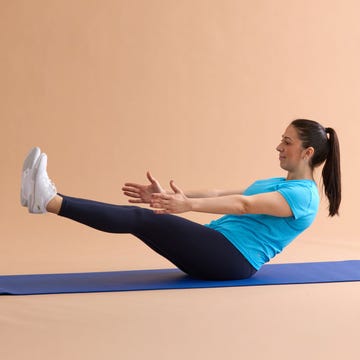- Tummy time helps infants strengthen their neck, arms, shoulders and core, but people on TikTok say adults can use it to improve posture, alleviate "tech neck" and reduce muscle pain.
- Try it by laying face down and propping yourself on your elbows with proper neck and spine alignment. Start with short sessions (10 seconds) and gradually increase.
- Tummy time may not be safe for everyone, particularly those with back issues.
Is there anything sweeter than watching a baby happily stretched out on their stomach? Massive cuteness factor aside, "tummy time" plays an important role in an infant’s physical development, helping strengthen their neck, arms, shoulders and core muscles.
Within days of a child's birth, the American Academy of Pediatrics recommends placing them on their stomach on a blanket on the floor for short periods of playtime (3 to 5 minutes at the beginning and working up to 15 to 30 minutes a day by two months old). Research has shown that tummy time improves gross and total motor skills in babies. It's particularly helpful in building up the stamina needed for sitting up, crawling and walking.
Now, there’s a new take on tummy time: Thanks to TikTok, it’s currently a trendy activity adults are trying out to improve their posture. Is it effective? “Tummy time is helpful for adults if they spend a disproportionate amount of time sitting, which can lead to muscle imbalance and in some cases, neck and low back pain,” says Thea Katrina R. Cohen, P.T., M.P.A., a senior II physical therapist affiliated with Montefiore Health System in Bronx, New York. “Prolonged sitting can lead to slouching, which can result in tight neck and abdominal muscles. Tummy time helps improve your posture, as it stretches tight flexor muscles, and strengthens your spinal extensors. This then helps keep your spine in neutral alignment.”
Another theory is that tummy time can help with "tech neck." If you spend a ton of time leaning over your computer and phone, “tummy time may reduce the forward curve that these positions create, which creates less tension on the neck and back,” says Heather Jeffcoat, P.T., D.P.T., a spokesperson for the American Physical Therapy Association and a physical therapist in Sherman Oaks, CA.
Want to try out tummy time for yourself? Keep reading for all the tips you need to do it correctly — and safely. First, let’s figure out if your posture could use an upgrade.
What are the symptoms of poor posture?
According to Brown University, you may not be standing or sitting straight and properly if you experience any of the signs outlined below. Of course, these symptoms could be caused by a number of things, but if you notice they occur when you’re slumped or hunching, they're likely to be posture-related:
- Pain in your back, neck and shoulders
- Stiffness
- Peeing when you put pressure on your stomach or bladder
- Heartburn or GI discomfort, as a slouched position can send your stomach acid in the wrong direction
How can an adult do tummy time?
Start with the proper position: “Lie face down on the floor or on your bed, then prop yourself up on your elbows,” suggests Jeffcoat. “Keep your neck in line with your spine — don’t let your neck hang down or flex. Now, gently pull in your abdominal muscles to protect your back. Roll your shoulders down and back to properly engage your shoulder girdle muscles, and reduce strain on your neck.”
Tummy time might look relaxing, but it can be tiring at first. “If you feel fatigued, start with holding the position 10 seconds at a time, and do 3 to 6 repetitions,” Jeffcoat says. “You can do tummy time every 2 to 3 days, as long as you’re not experiencing any increase in shoulder, neck or back pain.” Gradually, increase your endurance. “Add another 5 seconds and 1 to 2 repetitions to your routine,” she continues.
Once you get into the tummy time groove, you can do it while multitasking, too. “Instead of sitting while watching TV or browsing the internet on your phone or tablet, try lying on your stomach while doing the same activities to build up your trunk strength,” suggests Cohen. You can work up to 10-minute sessions or longer over time, she adds.
Is tummy time safe for everyone?
No. If you have back issues, lying on your stomach counters the natural curve of your spine and can cause painful pressure, according to the National Spine Health Foundation. You should also avoid tummy time in your second and third trimesters of pregnancy — definitely talk to your ob/gyn about it. If you have any health condition that might require clearance before you exercise, ask your healthcare provider if tummy time is safe for you.
“It’s important to note that you don’t always feel pain or discomfort during the exercise,” Jeffcoat says. “Monitor how you feel in the first 24 hours after trying this or any new exercise, to see if you have any adverse effects.” Simply put, if it hurts, stop.
What are other ways you can improve your posture?
If tummy time isn’t right for you — or if you want to supplement it for even better posture progress — you have more options. Try these easy lifestyle changes:
The bottom line
Tummy time can be a great way to boost your posture — but it’s important to listen to your body, and your health care provider, to make sure it’s the right choice for you.














